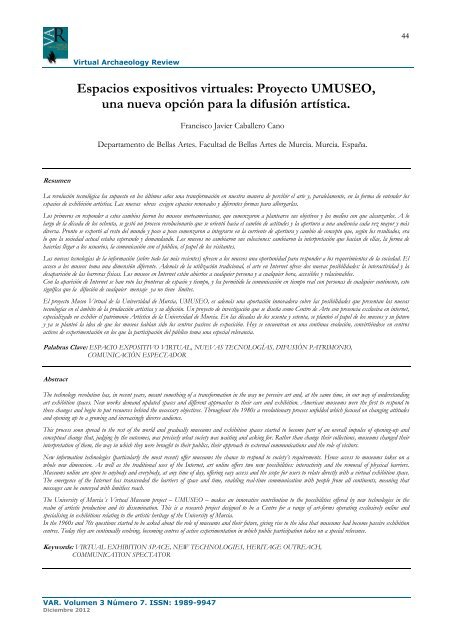Virtual Museums
Virtual Museums
Virtual Museums
Create successful ePaper yourself
Turn your PDF publications into a flip-book with our unique Google optimized e-Paper software.
Resumen<br />
<strong>Virtual</strong> Archaeology Review<br />
Espacios expositivos virtuales: Proyecto UMUSEO,<br />
una nueva opción para la difusión artística.<br />
VAR. Volumen 3 Número 7. ISSN: 1989-9947<br />
Diciembre 2012<br />
Francisco Javier Caballero Cano<br />
Departamento de Bellas Artes. Facultad de Bellas Artes de Murcia. Murcia. España.<br />
La revolución tecnológica ha supuesto en los últimos años una transformación en nuestra manera de percibir el arte y, paralelamente, en la forma de entender los<br />
espacios de exhibición artística. Las nuevas obras exigen espacios renovados y diferentes formas para albergarlas.<br />
Los primeros en responder a estos cambios fueron los museos norteamericanos, que comenzaron a plantearse sus objetivos y los medios con que alcanzarlos. A lo<br />
largo de la década de los ochenta, se gestó un proceso revolucionario que se orientó hacia el cambio de actitudes y la apertura a una audiencia cada vez mayor y más<br />
diversa. Pronto se exportó al resto del mundo y poco a poco comenzaron a integrarse en la corriente de apertura y cambio de concepto que, según los resultados, era<br />
lo que la sociedad actual estaba esperando y demandando. Los museos no cambiaron sus colecciones: cambiaron la interpretación que hacían de ellas, la forma de<br />
hacerlas llegar a los usuarios, la comunicación con el público, el papel de los visitantes.<br />
Las nuevas tecnologías de la información (sobre todo las más recientes) ofrecen a los museos una oportunidad para responder a los requerimientos de la sociedad. El<br />
acceso a los museos toma una dimensión diferente. Además de la utilización tradicional, el arte en Internet ofrece dos nuevas posibilidades: la interactividad y la<br />
desaparición de las barreras físicas. Los museos en Internet están abiertos a cualquier persona y a cualquier hora, accesibles y relacionables.<br />
Con la aparición de Internet se han roto las fronteras de espacio y tiempo, y ha permitido la comunicación en tiempo real con personas de cualquier continente, esto<br />
significa que la difusión de cualquier mensaje ya no tiene límites.<br />
El proyecto Museo <strong>Virtual</strong> de la Universidad de Murcia, UMUSEO, es además una aportación innovadora sobre las posibilidades que presentan las nuevas<br />
tecnologías en el ámbito de la producción artística y su difusión. Un proyecto de investigación que se diseña como Centro de Arte con presencia exclusiva en internet,<br />
especializado en exhibir el patrimonio Artístico de la Universidad de Murcia. En las décadas de los sesenta y setenta, se planteó el papel de los museos y su futuro<br />
y ya se planteó la idea de que los museos habían sido los centros pasivos de exposición. Hoy se encuentran en una continua evolución, convirtiéndose en centros<br />
activos de experimentación en los que la participación del público toma una especial relevancia.<br />
Palabras Clave: ESPACIO EXPOSITIVO VIRTUAL, NUEVAS TECNOLOGÍAS, DIFUSIÓN PATRIMONIO,<br />
COMUNICACIÓN ESPECTADOR<br />
Abstract<br />
The technology revolution has, in recent years, meant something of a transformation in the way we perceive art and, at the same time, in our way of understanding<br />
art exhibition spaces. New works demand updated spaces and different approaches to their care and exhibition. American museums were the first to respond to<br />
these changes and begin to put resources behind the necessary objectives. Throughout the 1980s a revolutionary process unfolded which focused on changing attitudes<br />
and opening up to a growing and increasingly diverse audience.<br />
This process soon spread to the rest of the world and gradually museums and exhibition spaces started to become part of an overall impulse of opening-up and<br />
conceptual change that, judging by the outcomes, was precisely what society was waiting and asking for. Rather than change their collections, museums changed their<br />
interpretation of them, the way in which they were brought to their publics, their approach to external communications and the role of visitors.<br />
New information technologies (particularly the most recent) offer museums the chance to respond to society’s requirements. Hence access to museums takes on a<br />
whole new dimension. As well as the traditional uses of the Internet, art online offers two new possibilities: interactivity and the removal of physical barriers.<br />
<strong>Museums</strong> online are open to anybody and everybody, at any time of day, offering easy access and the scope for users to relate directly with a virtual exhibition space.<br />
The emergence of the Internet has transcended the barriers of space and time, enabling real-time communication with people from all continents, meaning that<br />
messages can be conveyed with limitless reach.<br />
The University of Murcia´s <strong>Virtual</strong> Museum project – UMUSEO – makes an innovative contribution to the possibilities offered by new technologies in the<br />
realm of artistic production and its dissemination. This is a research project designed to be a Centre for a range of art-forms operating exclusively online and<br />
specialising in exhibitions relating to the artistic heritage of the University of Murcia.<br />
In the 1960s and 70s questions started to be asked about the role of museums and their future, giving rise to the idea that museums had become passive exhibition<br />
centres. Today they are continually evolving, becoming centres of active experimentation in which public participation takes on a special relevance.<br />
Keywords: VIRTUAL EXHIBITION SPACE, NEW TECHNOLOGIES, HERITAGE OUTREACH,<br />
COMMUNICATION SPECTATOR<br />
44


